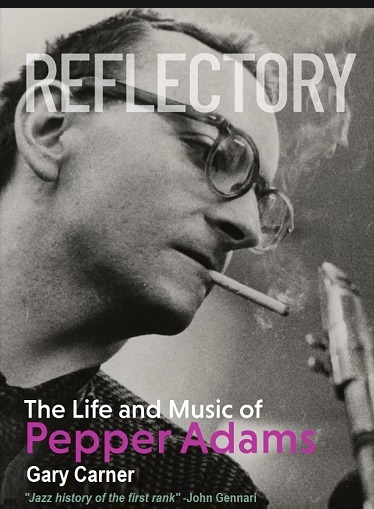© Gary Carner. Copyright Protected. All rights reserved.
I heard back from Pug Horton. It turns out that she and Bob Wilber have a son that lives in Atlanta. They expect to visit him sometime in 2016. It looks like my interview with Wilber will be put off until that time. Apparently, he prefers to do it in person. Something to look forward to, for sure!
I just found Pepper Adams' very first 8-track jazz "olio" that he put together. (
See https://instagram.com/p/6-7Bfzpnmp/?taken-by=pepperadamsblog.) Adams assembled about 40 of these collections to enjoy while motoring around to gigs, etc. Since this first one includes Dedication and Consummation from the Thad Jones-Mel Lewis date
Consummation, I figure that Pepper started making these particular sets sometime in late 1971, when the LP was likely released. If these were the first things Pepper made on 8-track, then he would have purchased his Wollensak-3M 8-track (
see https://instagram.com/p/rm4zHfpnj3/?taken-by=pepperadamsblog) recorder sometime that year--that is, if he didn't make a bunch of 8-track classical recordings beforehand. What's interesting about this first selection of tunes is the titles he chose. Here's the roster:
1. Duke Ellington: Fade Up
2. Tony Coe: Regrets
3. Pepper Adams: One Mint Julep
4. Thad Jones-Mel Lewis: Dedication
5. Yusef Lateef: Ma, He's Makin' Eyes at Me
6. Barrry Harris: Like This
8. Billy Mitchell: A Little Juicy
9. Bud Powell: Dusk in Sandi
10. Duke Ellington: All Day Long
11. Pepper Adams: Port of Rico
12. Blue Mitchell: Smooth as the Wind
14. Thad Jones-Mel Lewis: Consummation
15. Joe Henderson: Without a Song
16. Pepper Adams: Azurete
17. Duke Ellington: Rock Skippin' at the Blue Note
18. Music, Inc (Charles Tolliver/Stanley Cowell): Ruthie's Heart
19. Pepper Adams: Moten Swing
What can we make of this? Of the 19 cuts, 1 (#18) was previously unknown to me, 3 are Ellington, 5 are Pepper's dates as a leader or co-leader, 7 are recordings he appears on (it would have been 9 had he not missed most of the Consummation recording), and 12 are led or co-led by Detroiters. I'm especially taken that Pepper would include the four unissued Motown cuts that he did in 1963. Those wonderful tracks, with arrangements by Thad Jones, remain unissued to this day. I've been trying to get Universal to release them.
1. Hank Jones: Fugue Tune
2. Joe Henderson: Invitation
3. Charlie Parker: Repitition
4. Yusef Lateef: Quarantine
5. Duke Ellington: Just Scratching the Surface
8. Tony Coe: Together
9. Dizzy Gillespie: Serenade to Sweden
10. Ben Webster: Did You Call Her Today
11. Mike Westbrook: Portrait
12. Rubberlegs Williams: What's the Matter Now
13. Duke Ellington: Mr. Gentle and Mr. Cool
14. John Coltrane: Time After Time
What can we make of these cuts, especially as compared to #1? More Ellington and Coe, and, to be sure, a bunch of Detroiters again, plus another surprise cut for me by Rubberlegs Williams. Thank goodness for YouTube, here's the tune: https://m.youtube.com/watch?v=CvGNw9xKp70. It's a Charlie Parker feature from 1945. Flanagan's Solacium (whatever does that mean?) is new to me too. It features early solos by the leader, Coltrane, Idrees Sulieman and Kenny Burrell. The Eckstine tune has Leo Parker on baritone (on the studio version), though I'm not sure if he's audible. This is one of the first great bop bands. This a smoking live version, possibly not what Pepper chose, but presumably with a fantastic Fats Navarro solo and Budd Johnson on tenor. What a great chart. Did Johnson write it?
Shall we check out one more? Here's Pepper's sixth 8-track olio:
1. Duke Ellington: Perdido
2. Freddie Hubbard: Latina
3. Rex Stewart: Georgia on My Mind
4. Bud Powell: Hallelujah
5. Duke Ellington: Primpin' for the Prom
8. Duke Ellington: Tootin' Through the Roof
10. Thad Jones: Let's Play One
13. Bud Powell: I Want to Be Happy
14. Duke Ellington: Boy Meets Horn
15. Louie Bellson: The Jeep is Jumpin'
16. Ben Webster: The Days of Wine and Roses
How about that exchange on #7 between Cootie Williams and Rex Stewart? #9 surprised me: Quite free, and with no Surman bari solo.
What fun it's been getting into the heart and mind of Pepper Adams! I hope you've enjoyed the ride.





